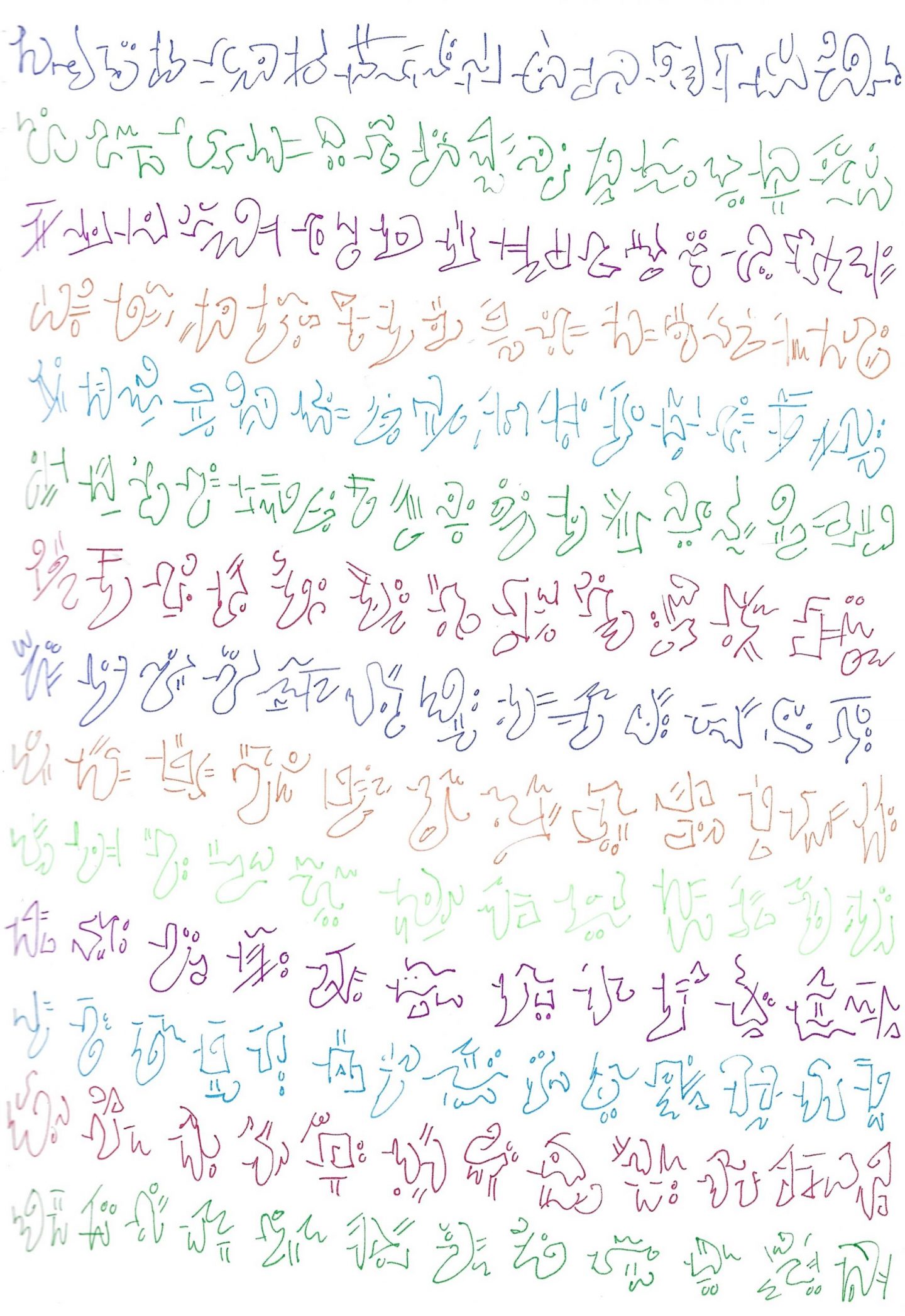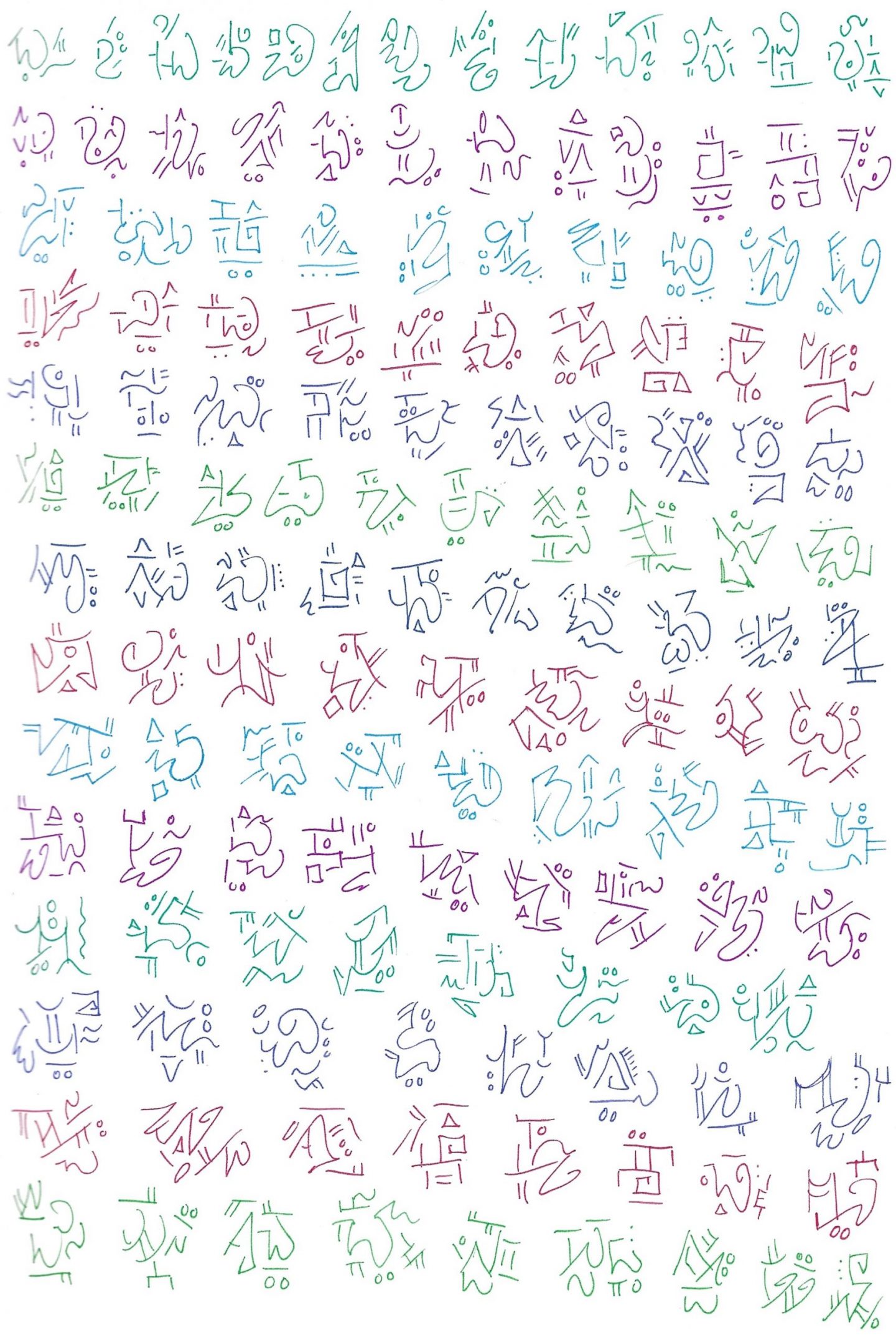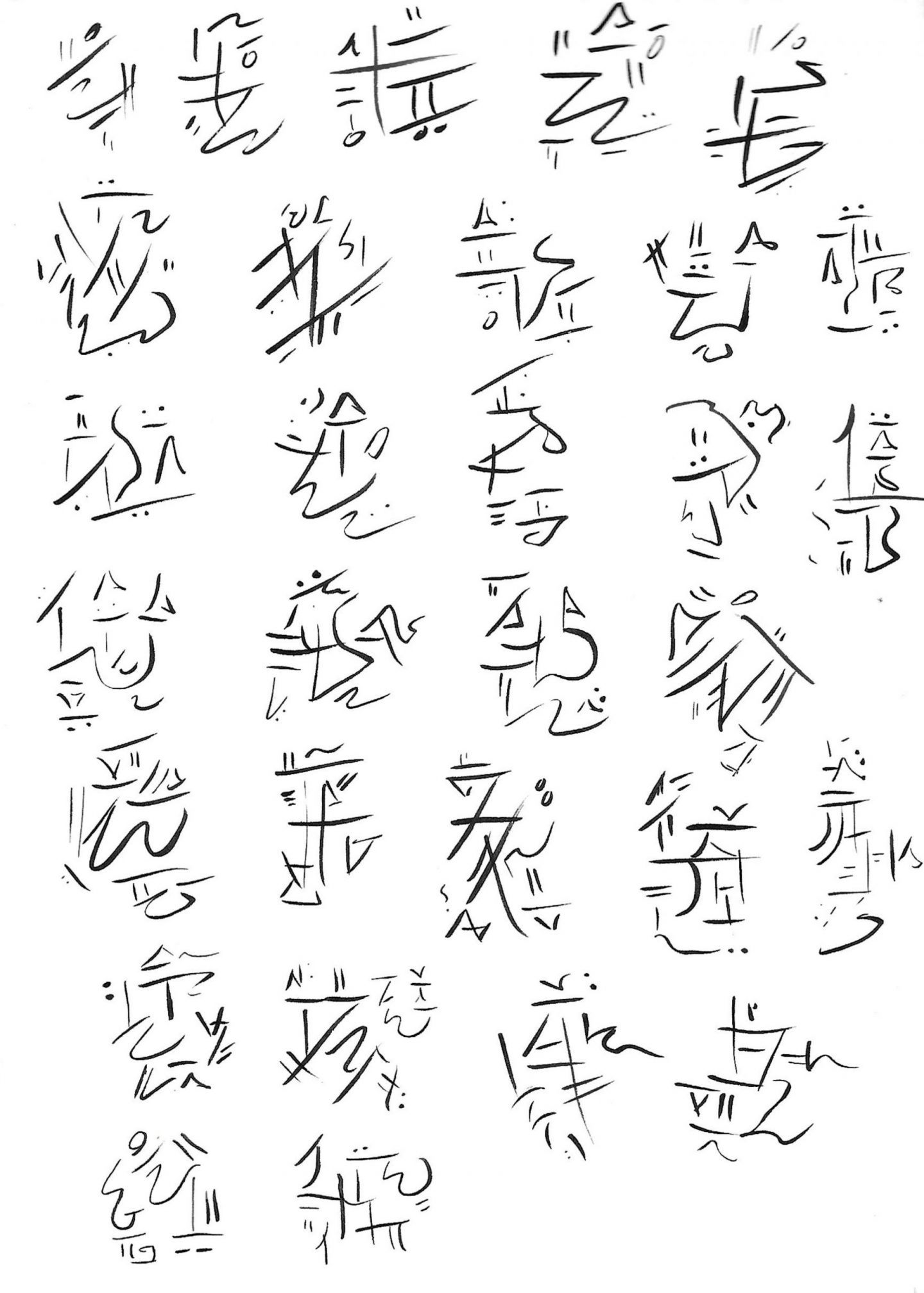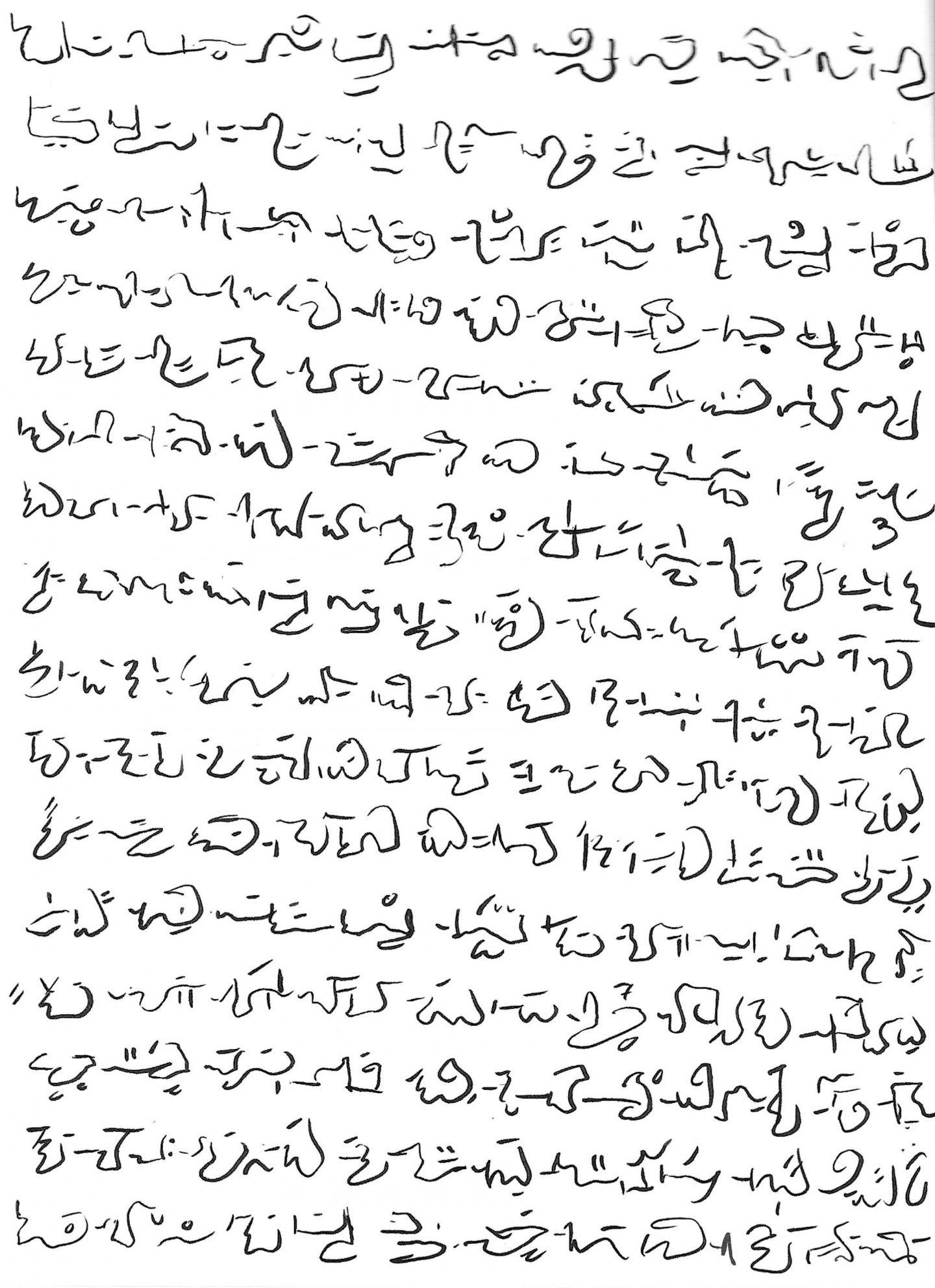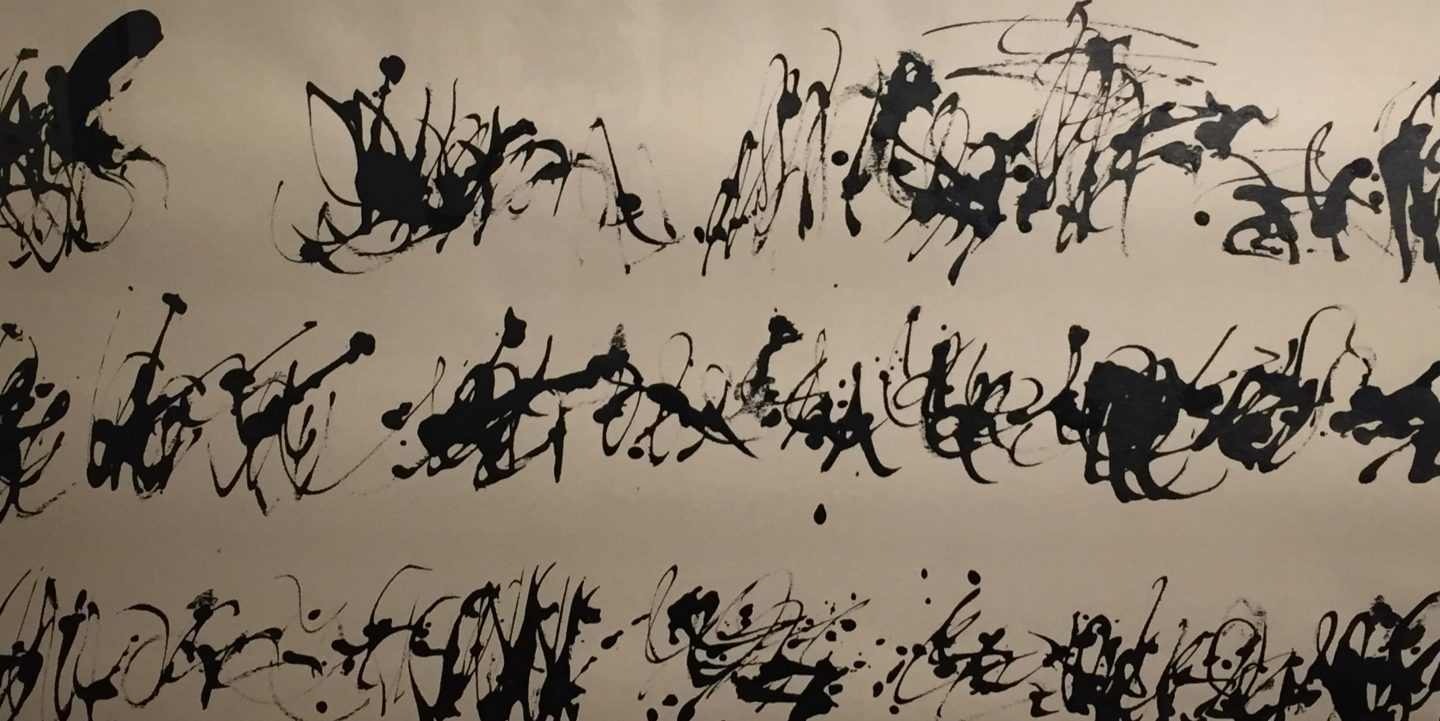
Detail from Henri Michaux’s piece Peinture à l’encre de Chine (1959)
Pseudographia is the term I use to refer to either the practice of automatic asemic writing, that is, wordless, artistic writing created in an unconscious way, or the unconscious drive to engage in such writing. I have recently been revisiting the work of the Belgian poet and artist Henri Michaux, as I feel his asemic writing is the perfect example of pseudographia.
Michaux arrived in Paris from Belgium in 1924, the same year that André Breton – the French writer and founder of the surrealist movement – published the first surrealist manifesto. This manifesto, which defined surrealism as “pure psychic automatism”, championed automatic writing, which Breton believed could uniquely reveal the contents of the human unconscious. However, in 1925, Michaux penned a critique of Breton’s manifesto, levelling two main criticisms, which the poet Gillian Conoley summarises in an interview for the Poetry Foundation:
One was that he didn’t believe the human hand could move fast enough to capture human thought, and in particular, the speed or accelerations of whatever might be going on in the unconscious. The other was that he didn’t think language as a construct or system was quick enough to access thought either. For Michaux, it seems that automatic writing would look like something closer to what he was doing with “Alphabet,” marks which could move faster since they didn’t concern themselves with either language or straightforward representational gesture.
This is an interesting point. If the aim of automatic writing is to represent the unconscious as fully as possible, then relying on a real, meaningful language may not be the best route towards this representation. We can question just how unconscious automatic writing is since it uses real words, phrases, sentences, and syntax – does not this involve elements of conscious thought? Morton Prince, an American neurologist who focused on abnormal psychology, believed this to be the case. He stated in his paper Some of the Revelations of Hypnotism (1890) that ““automatic writing” is not a purely unconscious reflex act, but, the product of a conscious individuality.”
Conoley – who published the first English translation of Michaux’s Thousand Times Broken: Three Books (1956-1959), a volume of poetry, prose, and art – writes that Michaux “seems most interested in thought before it finds expression, its origin.” And so he sought to liberate himself from language – from semantically filtered thoughts – through the medium of asemic writing. While asemic writing can end up appearing similar to real languages (such as in Michaux’s Mouvements project, which features figures reminiscent of traditional Chinese calligraphy), this art form does not rely on constructing semantic meaning, so one can instead make gestural movements with the hand purely based on unconscious feeling. Michaux regarded written language as somehow disfiguring, an act that compromised the original creative impulse. Through his works of asemic writing, like Alphabet (1925), Narration (1927), and Mouvements (1950-1951), Michaux instead relied on gesturally drawn characters. These are attempts to spontaneously match form with feeling.
Rather than use the straightforward representational gesture one would use when writing meaningful words in automatic writing, Michaux experimented with unconstrained gestures, emanating from whatever “interior gestures” (to use his phrase) he was experiencing. These interior gestures (or “pre-gestures” as he also calls them) are the internal movements and impulses we have. In a poem from his Mouvements project, he describes these pre-gestures as movements of “inner exasperation”, “explosions”, “refusal”, “inner shields”, “impossible desires”, “stretching every which way”, as movements which “one cannot display but which dwell on the mind”. He goes on to say these are gestures of “the ignored life”, “the impulsive life”, “defiance”, “retort”, “excess”.
In much of his work, Michaux attempted to bring these movements to the surface via the gestural movements of the hand. It is curious, then, to see results like Mouvements, with India-ink drawings which not only look like the brush strokes of Chinese calligraphic artists, but also like highly expressive, moving, and dancing human figures. In some figures, there is a sense of flailing, reaching, contracting, opening up. The Canadian choreographer Marie Chouinard translated Michaux’s figures into dance, bringing these gestures to life.
Nevertheless, if the hand cannot move fast enough to capture thought, as Michaux concedes, then no form of writing or drawing can ever truly communicate thought. So what we see in Michaux’s work, therefore, is the attempt to closely represent thought. Even though Michaux regarded automatic writing as impossible, as not being able to translate the unconscious, he still practised some version of it. This seems to speak to the human predicament of existential isolation: wanting to truly communicate one’s inner world to another – so as to be heard, seen, and understood – and yet never being able to satisfy this wish.
In Thousand Times Broken, created during the artist’s multi-year experimentations with mescaline, “Michaux continues to explore his lifelong fascination and tormented investigation of whether the self can be accessed, whether words or drawings best capture meaning, and whether communication is possible at all,” writes Caite Dolan-Leach in a piece for Music & Literature. Michaux was trying to access his unconscious through his mescaline experiences and to “illustrate it in as unfettered a way as possible,” Dolan-Leach adds. But even if his mescaline-influenced drawings are the apotheosis of Michaux’s translation of his unconscious mind, Dolan-Leach stresses that:
Michaux seems to be devoted to something for which failure is inevitable: translating the within of the inner self to the without of a medium, be it language or drawing. And ineluctably feeling frustration and discontent with the results. All three texts in this volume return to Michaux’s sense of inadequacy, of falling short.
Indeed, Michaux took issue with drawing as well, asserting that, like writing, it was a conscious construct with – as Conoley says – “conventions and agendas of [its] own, and therefore problematic in accessing or representing anything, much less deeper levels of consciousness.” So Michaux, throughout his artistic career, decided to focus on asemic writing. Michaux sought to find a universal language – based on gestures – that was “somewhere between writing and drawing,” remarks Conoley.
In the text Peace in the Breaking (1956), which appears in Thousand Times Broken, Michaux refers to Chinese pictographic writing as “natural” in comparison to other forms of writing, and as Conoley observes, “Michaux was intensely attracted to the ideogram as part of his desire for a universal language, where image and word could unite.” Dolan-Leache notes that Michaux’s writing in this volume is “steeped in an affect of isolation,” adding that “it’s hard not to read his desire to achieve a universal language as a profoundly lonely plea for true communication.”
In the spirit of surrealism, pseudographia – or automatic asemic writing – could still reveal the unconscious, through spontaneous gestures, in ways that cannot be achieved through the automatic writing that Breton had in mind. In my previous blog posts on asemic writing (see here and here), I talked about how when I engage in asemic writing that it feels like an unconscious, spontaneous activity. But I think that much of this writing has been more semi-automatic in nature; it is partly unconscious (in that I do not have pre-imagined figures that I want to recreate) and partly conscious (in that the movements aren’t purely reflexive and spontaneous – there is some conscious thought and decision-making guiding the strokes). For this reason, I have tried experimenting with much quicker strokes, trying as best I can not to put conscious activity into how the characters should look. I have included some examples below.
